 Hawaiian Name(s): koai‘a, koai‘e, koa‘ohā
Hawaiian Name(s): koai‘a, koai‘e, koa‘ohāScientific Name: Acacia koaia
Vernacular Name: none
Family: Fabaceae
Status: endemic
Authority: Hillebr.
Description: Tree 7-8 m tall.
Habitat Rare in dry areas and open habitats on leeward sides of Lāni‘i, Molokai, Maui and Hawai‘i (Wagner et al. 1990:642).
Medicines: To treat illnesses on the skin, koai‘a leaves and bark, ‘auko‘i (Senna occidentalis) and kikania stalks (Desmodium sandwicense) are ground together. Water is added and the mixture is heated; the patient takes a steam bath or puholoholo (Chun 1994:1156–157).
Non Medicinal Uses: Wood, which is harder than the koa, was used for spears and decorative paddles; primary wood used for beaters (Hillebrande 1888:112; Krauss 1993:63). Wood also used for house timbers and carved fish hooks (Krauss 1993:43; Lamb 1981:47–48; Malo 1951:21), also in musical instrument (‘ukeke) (Krauss 1993:85).
Specific gravity of wood: unknown
Famous Locations:
Mele: "Niniau ‘eha ka pua o ke koai‘e" line in "Hole Waimea" (Elbert & Mahoe 1970).
`Ōlelo Noeau:
Dye Color and Parts: Yellow (flowers)
Kino lau:
Location on Bishop Museum Kalihi Campus:
Propagation Information: Intermediate. Presoak seeds; when seedlings reach 10 cm begin to fertilize, plantout in full sun at height of 30-50 cm, lightly fertilize & water well; are highly drought resistant; monitor for insects (Bornhorst 1996:60–61; Bornhorst and Rauch 1994:15–16; Culliney and Koebele 1999:81–83). Hawaiian Native Plant Propagation Database.
Native Plants Hawaii.
Microscopy
Cross Section: Field of view: 2.6 mm x 1.6 mm. Photograph: H.Lennstrom.

Radial Section: Field of view: 2.6 mm x 1.6 mm. Photograph: H.Lennstrom.

